Landscape Architecture for Landscape Architects › Forums › GRAPHICS › Looking for Rendering Critique
- This topic has 1 reply, 5 voices, and was last updated 15 years, 1 month ago by
 Amy Verel.
Amy Verel.
-
AuthorPosts
-
November 23, 2010 at 9:43 pm #166802
 Frank VarroParticipant
Frank VarroParticipantHey guys,
I’m working on getting a freelance Architectural and Landscape Architectural rendering gig going using a newish engine called Thea, and wanted you guys to look at a few of the component models I have so far. Let me know what you think. The car and bench are tweaked Sketchup components that I re-skinned, the trees are from Tree[d], which the exception of the pine, which someone shared in the Thea forums. The Stop sign is original, and the people are default SketchUp people, and I’m not sure if they are the way I am going to end up doing people or not.I’m trying to get these set so anytime anyone needs a design with a maple rendered, I’m ready to plug this in.
First, the trees. I spend a LOT of time with these trying to get not just the right bark, the and the right shade of leaf, but the right translucency, as its what seems to give the leaves a look of life. The redbud was a real trick since when it is in bloom its a very skeletal structure, and is VERY pink, but at times it looked almost on fire.
Maple-
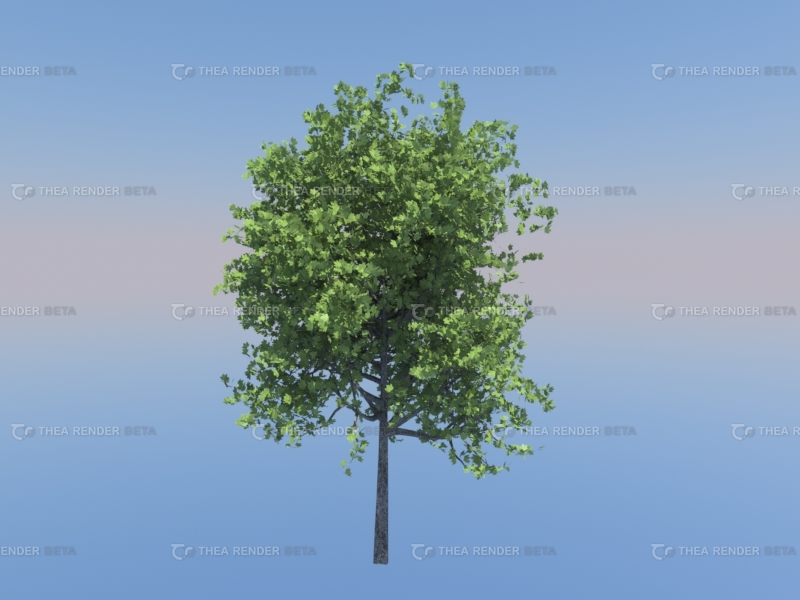
Ginko (Young)-
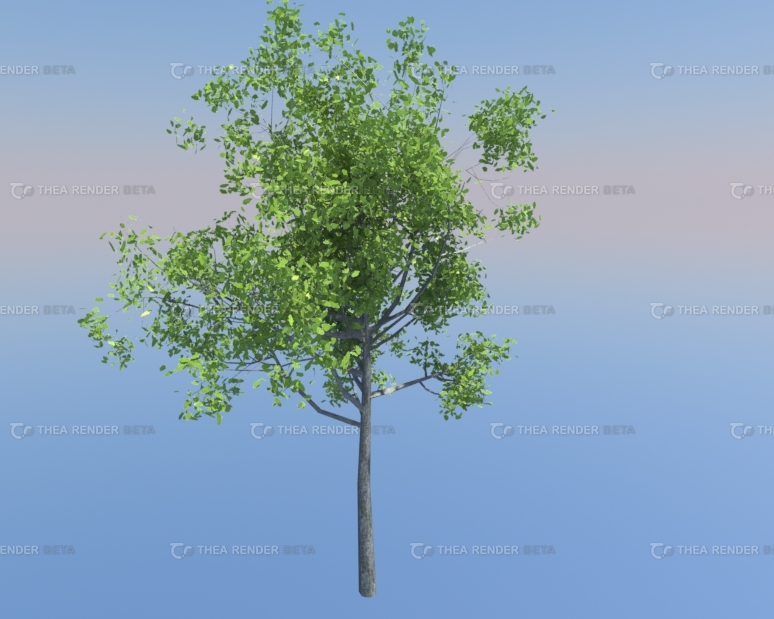
Redbud-
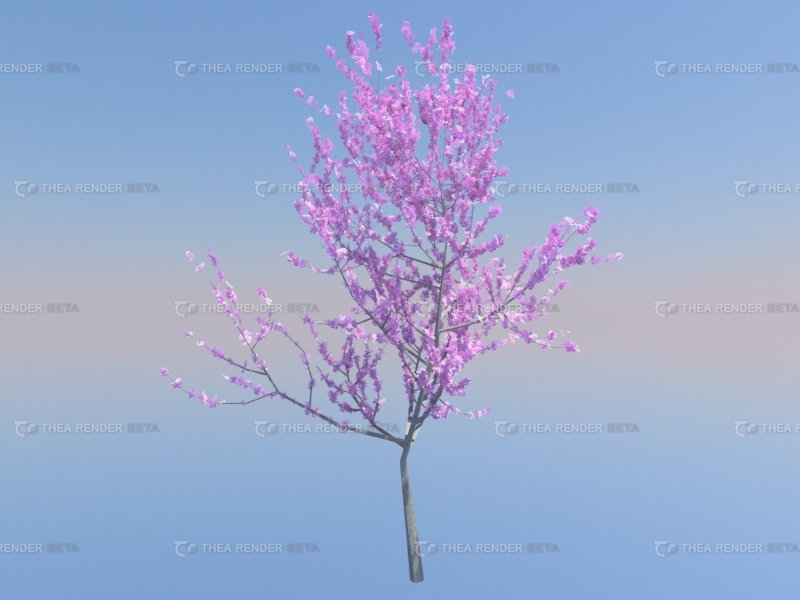
Next is the park bench. I used a Sketchup component, and tweaked the model SLIGHTLY, and reskinned it in thea.
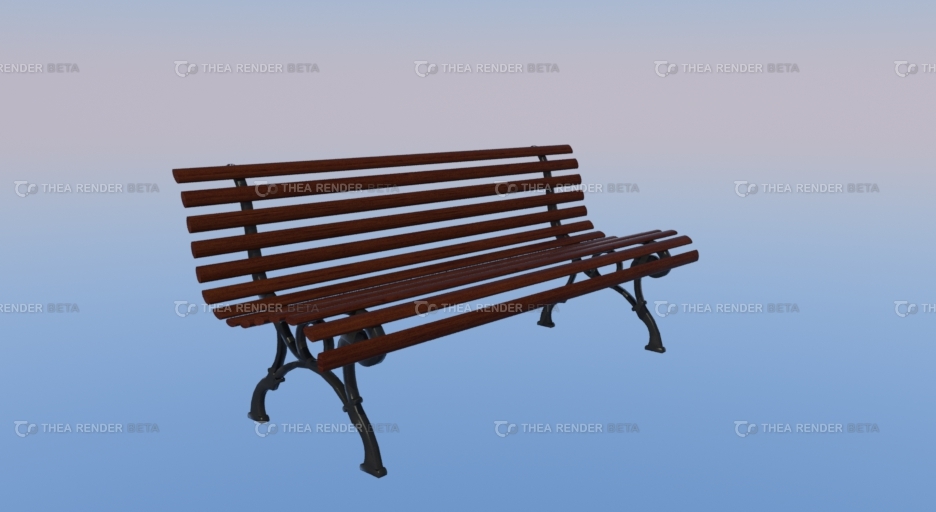
The stop sign is the first piece I made 100% on my own, and I’m decently happy with. I have NO idea if you can get it to act like there is the reflective-prism film, so I just made it fairly reflective, but added a bumpmap so it doesn’t reflect straight back like a mirror.
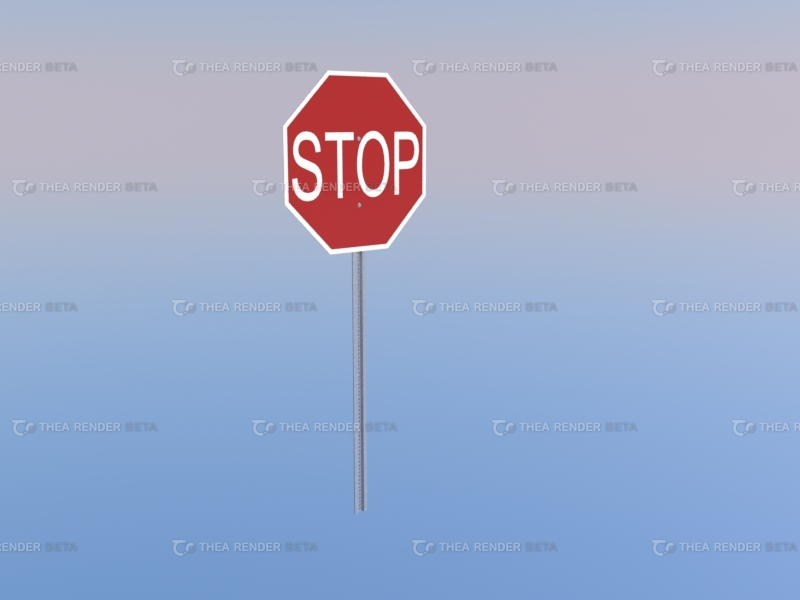
I’m pretty happy with my car. I got the model in Sketchup, and tweaked it to smooth some edges, add depth in areas like headlights, and then got the materials nailed down. The car here has its headlights off, but I do have two IES lights in the model so I can turn them on for night scenes.
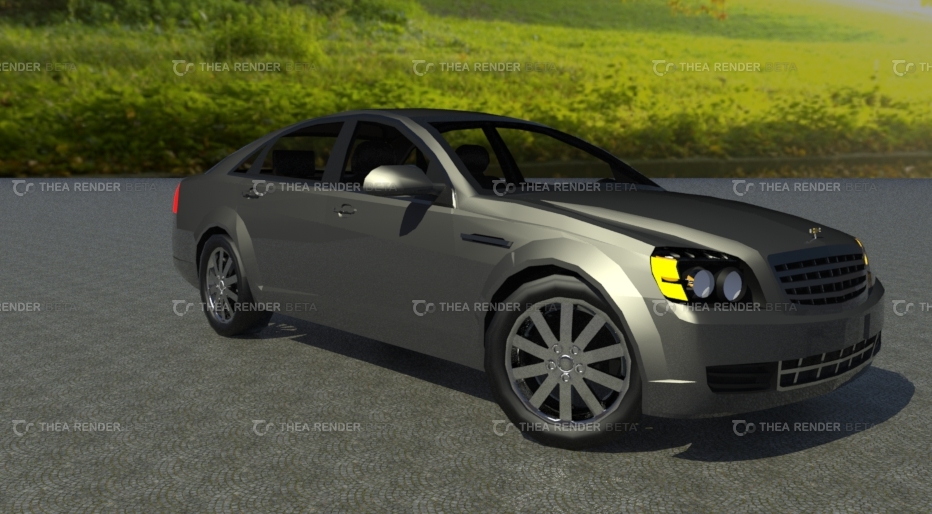
Lastly, here is everything thrown together in one mish-mash. The key thing here is that the car, for instance, will never be the focal point
of a model. so while as a stand alone you see
the polys, when its in a model as a set piece, the fact that it reflects the model and sits so well really makes it an asset if you ask me… but I’m not asking me. I’m asking you. so let me know what you think!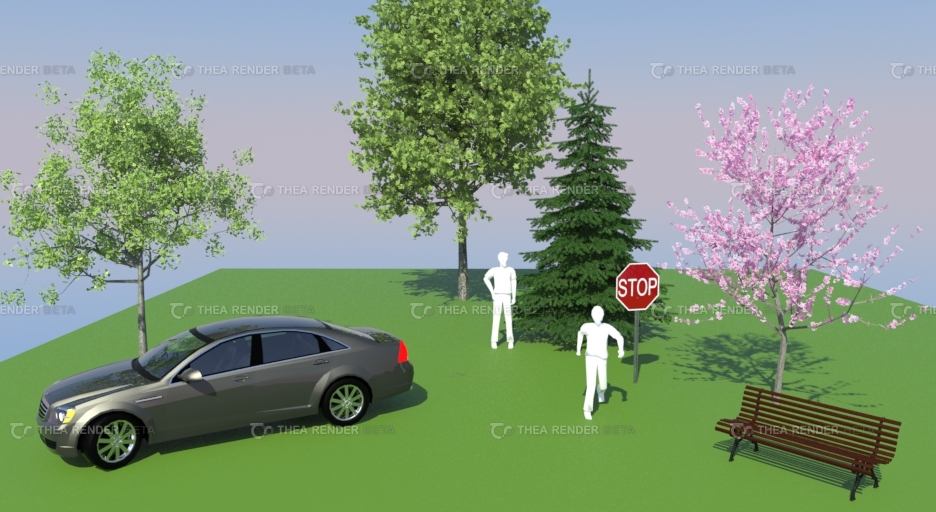
If you like the look of the engine (This is unlicensed version, full will not have the water marks), check out TheaRender.com
November 24, 2010 at 3:25 pm #166816 Amy VerelParticipant
Amy VerelParticipantLike! 😛
Actually the one thing I would say about the trees is that they could actually be a little bit more regular in form, especially the ginkgo and redbud. Obviously getting some irregularity to the form is necessary to achieve more realism, but the twigs sticking furthest out (mostly on the ginkgo) look a little too sparse and maybe a little too irregular. Maybe just fill them both in with more leaves.
November 24, 2010 at 3:46 pm #166815 Thomas J. JohnsonParticipant
Thomas J. JohnsonParticipantThe car is rad. It looks like a Mercedes-Maserati-Cadi-Charger hybrid… Classy muscle.
I agree with Amy’s observation about the trees. If I came across them on a site, I’d want to trim up those odd branches.
The people are too white… My eyes get stuck on them. Is there anyway to add a bit of color to them to mellow them out without compromising the look you’re going for?
Those are the only things I’d change. Otherwise, it looks rad. Very clean… nice texture and shadow.
November 24, 2010 at 10:56 pm #166814 Ryland FoxParticipant
Ryland FoxParticipantThe trees look pretty flat, especially the bark. Vray is the standard and Peter Guthrie has some pretty good examples via Onyx tree. http://www.peterguthrie.net/blog/2009/05/3d-trees/ The wheel well and wheel on the car need smoothing and the light cover is to transparent, almost nonexistent. Looking at the Thea page it says the engine has displacement mapping so you can try it out and see how it goes. i guess it gets into how photorealistic you want to go.
I haven’t used Kerkythea in awhile but Thea at first glance Thea doesn’t look that advanced on it. What are the rendering times on the trees. Can you use proxies?
November 25, 2010 at 11:47 pm #166813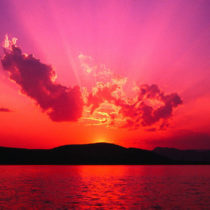 Steve MercerParticipant
Steve MercerParticipantHi Frank.
If you want to get serious about your trees check out xFrog: http://www.xfrog.com/products/productStart.htm. It is the only company that I am aware of that allows you to export your texture maps and you tree models in one file. You export them in .obj file format and bring them into SU pro. See my discusion on the Sketchup Group: http://land8lounge.com/group/sketchup/forum/topics/3d-tree-models
Hope this helps.
s.
November 26, 2010 at 12:10 am #166812 Steve MercerParticipant
Steve MercerParticipantHi Frank,
I am curious. Can you create two tree models (one low res, one Hi res) The Xfrog files can be huge. If I could use Xrog’s companion program…Xfrogtune, I could generate a low res tree model of the same tree. Place the Low res image in SUpro.
Come time to render the SU model can your rendering engine swap out the low res tree models for the hi res tree models so SU won’t choke?
November 26, 2010 at 1:39 am #166811 Ryland FoxParticipant
Ryland FoxParticipantLooking at Thea’s website it says that it can use proxies which is fairly common with render engines now, but you wouldn’t place the low res tree you just place the high then turn it into a proxy so that it will display in the modelling program as a lower poly tree or even a box showing its extent.
November 27, 2010 at 11:43 pm #166810 Steve MercerParticipant
Steve MercerParticipantSU does not support proxies see my discussion on SketchUcation: http://forums.sketchucation.com/viewtopic.php?f=79&t=32927&p=290324#p290324
s.
November 28, 2010 at 10:45 pm #166809 Ryland FoxParticipant
Ryland FoxParticipantWaht is your work flow from Sketchup to Vue?
November 29, 2010 at 1:17 am #166808 Steve MercerParticipant
Steve MercerParticipantVue has a SU plugin that allows you to export your model into vue. Once there I select the components that need to replaced (plant material mostly) using the world browser on the lower right of the screen. I then Right click the selection -> Replace by [Keep Proportions](imports component without deforming it) Then choose what kind of component the new one will be…at the bottom of the menu is “Import Object”, this will let you import any file that Vue supports, including .obj. All my low res models that where created in xTune are named the same name as the Hi res model except I tack a “p” on the end of the file name. So my hi res imported object name is the same as my low res names without the “p’ on the end of the name. After I have completed replacing all of the low res trees with the hi res trees I am able to move forward to the rendering process.
s.
November 29, 2010 at 3:20 pm #166807 Frank VarroParticipant
Frank VarroParticipantRendering time for a single tree isn’t to bad, around 10 mins. I can proxy in Thea, I generally use them for when I have multiple trees, In engine it just shows as giant bounding boxes,then I have to render to get the actual tree to show, but It definitely saves on resources.
I tried some displacement mapping, the only issue is it tender to pull the materials apart at the edges if its not EXTREMELY carefully tweaked. I have SOME bump mapping on them, but need to work with both displacement and bump mapping to really get it to curve right.
November 29, 2010 at 3:24 pm #166806 Frank VarroParticipant
Frank VarroParticipantTree[d] allows the same thing. It exports to a 3ds Obj file, I know it opens correctly (with textures) in Thea, but I’ve heard of people having issues in SketchUp. The big reason I’m not using xFrog is that I don’t really have $400 to throw out for the engine, especially when Tree[d] gets such good results for free.
November 29, 2010 at 3:28 pm #166805 Frank VarroParticipant
Frank VarroParticipantMy workflow is basically that I model everything short of plants, benches, cars in sketchup, but I include 1′ diameter planes where a tree should go, with a material named for the tree that goes there (So I have 5 circles painted with “Maple”, 6 with “redbud”). I can then jump into Thea, and merge a maple tree model in. I select the maple tree and tell it to proxie auto-populate on my maple material no closer than 1 meter, and with random rotation and 10% scale variability. That way I get trees auto places, auto scaled, and proxied, giving a quicker, and more organic looking set of trees.
November 29, 2010 at 9:31 pm #166804 Steve MercerParticipant
Steve MercerParticipantI am going to write a python script that will automate the replacement of low res files with the high res files upon importation of my SU model into Vue 9 infinite. Vue 9 Infinite is required. in order to create my Python scripts. Infinite is the better choice anyway and has tighter integration with photoshop files
s.
November 30, 2010 at 1:48 am #166803 Steve MercerParticipant
Steve MercerParticipantMy work flow before SU:
We are a Survey/Design/Build firm.I start out by downloading a .shp file from the Counties GIS Map. It includes property lines, contours and Utility placement info. I bring that file into IntelliCAD/Carlson Desktop software. Trim all the info except for the property I am working on. I then export the file to Carlson’s SurvCE (software for my Survey Instrument’s data collector) I then take my Leica 1105 Robot to the field and setup on the job-site. After taking shots to two corners of the property lines already loaded in the data collector the gun is squared up with the shape file on the data collector. I then survey the property (all existing trees, and sidewalks, driveways, buildings etc.) the SurvCE software allows me to draw the geometry on my data collector as the shots are taken from the gun. The Gun is robotic so only one person need go to the job-site to do the survey. Once the survey is complete I come back to the office and import the drawing from SurvCE back into the Carlson Desktop software. Once tweaked and saved I call up BricsCAD/LandFX and do my design work. When complete I export the design through LandFX’s SU plug-in into SU pro. I create my 3d plants in a separate modeler called xFrog (complete with texture maps). These files are extremely large (and high quality) so I run them through xFrog’s xTune software to reduce the size (and quality of the file) I save the low res file to a slightly different name- ex. “XXXXXXd.obj” I now have two files with the same name only one file is low res with a “p” (for proxy) and the other file is the original file from xFrog-the high res file. The LandFX plug-in prompts you for the 3d replacement symbols to replace the 2d symbols that were originally placed in the LandFX design (3d xFrog models from xFrog xTune) for the 2D symbols used in LandFX. By placing the low res files in SU pro I am able to retain the design speed of SU pro. I use these symbols to place the correct size plant models in SU pro. After the model has been built in SketchUp Pro and Rendered in Vue 9 Infinite, The presentation is made to the client. If we get the Job I can export the SU Drawing back to LandFX through the LandFX plug-in then send it back to SurvCE and go back to the job-site and set my survey instrument up back on-site and perform a Stake-out of the job based on the quoted drawing. I am working on interfacing our accounting system’s Sales Order and Inventory system with LandFX. In this manner once the drawing is complete I can create my quote in our Sales order system. If I get the job I can merely turn the Quote into a workorder and from there into an Invoice without rekeying data.
-
AuthorPosts
- You must be logged in to reply to this topic.


